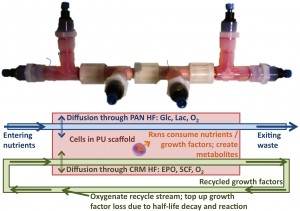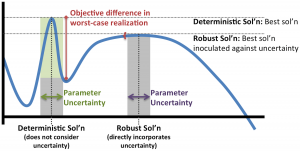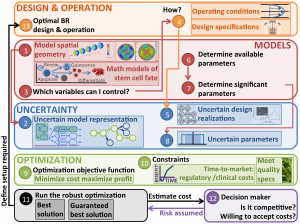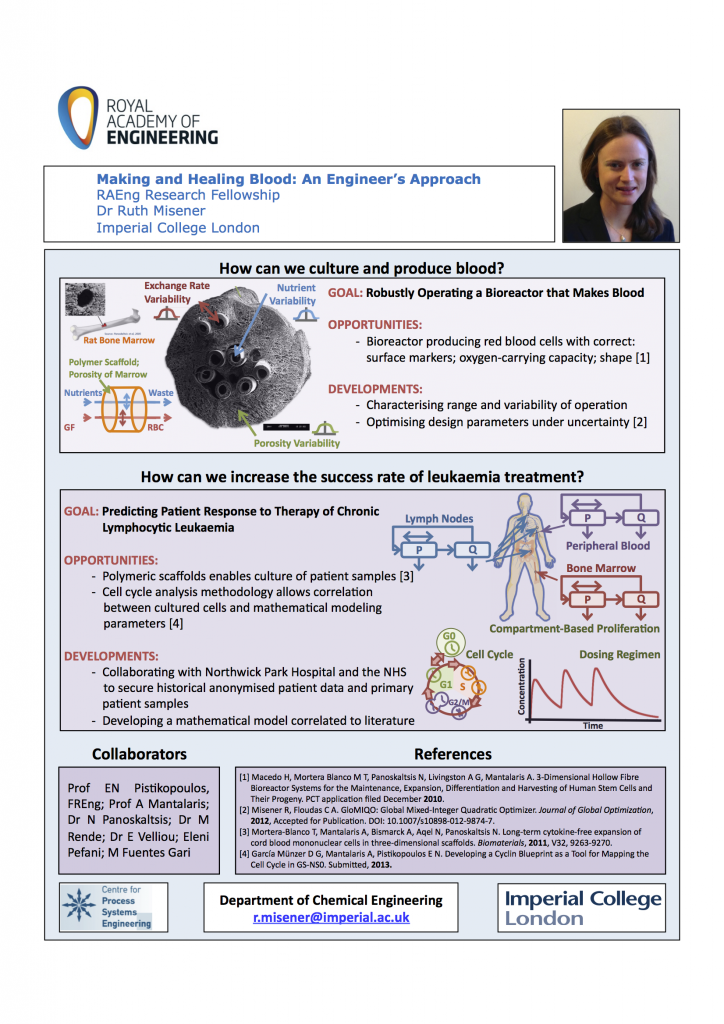 The Biological Systems Engineering Laboratory developed a novel, biomimetic, cost-effective three-dimensional hollow fibre bioreactor for growing healthy red blood cells ex vivo (Panoskaltsis et al., 2012). This bioreactor recapitulates architectural and functional properties of erythrocyte formation and thereby reduces the need for expensive growth factors by more than an order of magnitude. Individual experiments to empirically improve the bioreactor are intensive, so we propose global superstructure optimization for bioreactor design. Misener et al. (2014) integrate topological design choices with operating conditions. Design choices include: number of parallelised bioreactors; number and type of hollow fibres; size and aspect ratio. Operating conditions are: feed concentrations; flowrate through the reactor. We quantitatively demonstrate the potential for ex vivo red blood cell production to compete openly against the transfusion market for rare blood.
The Biological Systems Engineering Laboratory developed a novel, biomimetic, cost-effective three-dimensional hollow fibre bioreactor for growing healthy red blood cells ex vivo (Panoskaltsis et al., 2012). This bioreactor recapitulates architectural and functional properties of erythrocyte formation and thereby reduces the need for expensive growth factors by more than an order of magnitude. Individual experiments to empirically improve the bioreactor are intensive, so we propose global superstructure optimization for bioreactor design. Misener et al. (2014) integrate topological design choices with operating conditions. Design choices include: number of parallelised bioreactors; number and type of hollow fibres; size and aspect ratio. Operating conditions are: feed concentrations; flowrate through the reactor. We quantitatively demonstrate the potential for ex vivo red blood cell production to compete openly against the transfusion market for rare blood.
Robust Optimization Under Uncertainty

In stem cell biomanufacturing, an optimal but non-robust design may be sensitive to uncertainty. To see the possible trouble with parameter uncertainty, consider the figure at left (see full-sized image here). Misener et al. (2017) use robust optimisation to find the best solution inoculated against parameter uncertainty. We quantify the parameter uncertainty using image and material analysis tools (Allenby et al., 2017, Panoskaltsis et al., 2012).

The blood-producing bioreactor is also subject to model uncertainty, e.g. there are different possible mathematical representations for the transformation from progenitor to red blood cells. For the blood-producing bioreactor, we reformulated the model uncertainty into parameter uncertainty and incorporated it into the robust optimization problem.
The figure at right summarizes the Misener et al. (2017) recipe for stem cell biomanfacturing under uncertainty (see full-sized image here).
Extensions to Neotissue Growth Kinetics
Several of the optimisation techniques we developed for the blood-producing bioreactor are also relevant for other areas of tissue engineering. PhD student Simon Olofsson and I collaborated with the group of Professor Liesbet Geris to optimize bone neotissue growth in a perfusion bioreactor (Mehrian et al., 2017).
Collaborators
- Prof Sakis Mantalaris, Mark Allenby (Experimental bioreactor design)
- Dr Nicki Panoskaltsis (Haematology)
- Prof Stratos Pistikopoulos, Dr María Fuentes Garí (Mathematical modeling)
- Dr Eirini Velliou (Bioprocessing)
- Prof Liesbet Geris, Dr Mohammad Mehrian, Dr Simon Olofsson (Extension to bone neotissue growth)


